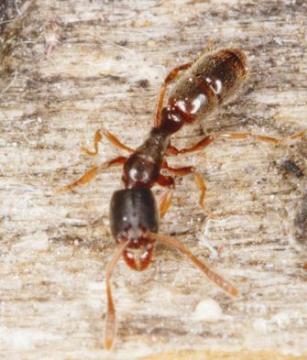Species Account for Ponera coarctata
Ponera coarctata (Latreille, 1802)
an ant
Aculeata: Formicidae: Formicidae

Reproduction for study and non-profit use permitted, all other rights reserved.
Taxonomic group: ants (Aculeata: Formicidae) - County data
View time series maps for Ponera coarctata
member log-on for taxon report
Status: Nb
Essex RDB: Listed
Threat: Essex Threatened
Images
upload a new image
Species text
Ponera coarcata is recorded sparingly in southern England. It is well represented in coastal areas, especially around the Thames estuary and Kent coast, and is also widely recorded inland in the Thames basin (especially in Greater London). It is a local species, perhaps under recorded because of its secretive habits and low density at sites. The ant is found beneath stones, mosses and leaf litter in a range of situations, including open stony ground, quarries, banks, chalk escarpments (apparently mainly where there are superficial clay deposits), landslips and soft rock coastal cliffs, even in the upper tidal zones of shores. Warm situations with wet soils seem to be preferred, and it seems to tolerate partial shade as long as sites are warm. There are several sites for this species in the suburbs of London, where it can inhabit pockets of waste ground, scrub and larger, less disturbed gardens. It is carnivorous and forms small nests with queens and workers, usually beneath stones and other objects. Workers are frequently found in and about other ant nests, including those of Lasius fuliginosus, L. flavus and F. fusca, and also amongst mosses. They retreat rapidly into crevices when disturbed and also remain elusive during periods of unfavourable weather (Falk 1991b). References
Habitats
Recorded management for locations with Ponera coarctata
Recorded substrate and hydrology for locations with Ponera coarctata
Why not join the Club, register and add a new species page
Interpretation of distribution maps



















